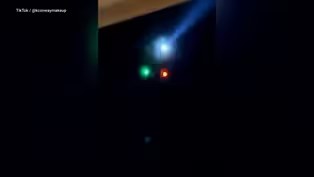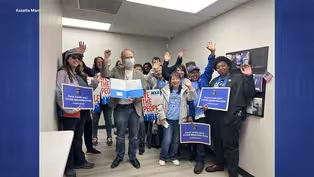NJ Spotlight News
Drug deaths decline sharply in NJ
Clip: 12/10/2024 | 6m 14sVideo has Closed Captions
Experts point to Narcan, treatment and other responses as reason overdose deaths are declining
Experts point to Narcan, treatment and other responses as reason overdose deaths are declining
Problems playing video? | Closed Captioning Feedback
Problems playing video? | Closed Captioning Feedback
NJ Spotlight News is a local public television program presented by THIRTEEN PBS
NJ Spotlight News
Drug deaths decline sharply in NJ
Clip: 12/10/2024 | 6m 14sVideo has Closed Captions
Experts point to Narcan, treatment and other responses as reason overdose deaths are declining
Problems playing video? | Closed Captioning Feedback
How to Watch NJ Spotlight News
NJ Spotlight News is available to stream on pbs.org and the free PBS App, available on iPhone, Apple TV, Android TV, Android smartphones, Amazon Fire TV, Amazon Fire Tablet, Roku, Samsung Smart TV, and Vizio.
Providing Support for PBS.org
Learn Moreabout PBS online sponsorshipNew Jersey is on track to record a sharp drop in drug related deaths, marking the third straight year in which drug fatalities decreased, giving advocates and families with loved ones who are struggling with substance abuse a beacon of hope.
Preliminary state data analyzed by NJ Spotlight News finds fatalities were 28% below 2023 levels and down significantly in three counties that have long led the state in overdose deaths Essex, Camden and Atlantic.
Experts say the decline isn't from any one thing alone, but a combination of efforts that have been taken at the local, state and federal levels.
For more, I'm joined by our health care writer, Lilo Stainton.
Lilo, great reporting here.
A lot of numbers to dive into.
What are some of the factors that experts pointed to or some of the public health initiatives that have contributed to this decline?
Well, whatever the numbers, I think, yeah, there's clearly a trend in, we would say the right direction.
And a lot of this has to do with, experts say harm reduction programs that are getting out there, into the streets and literally meeting people where they are to provide primarily Narcan, which are naloxone, which can reverse, an opioid overdose and also works on fentanyl.
You just have to sometimes use more.
But, that's a really important step.
Other, you know, needle exchange, clean needles mean less infection, less death from that.
Then we have, you know, addiction treatment, apparently, you know, there's less stigma around this, more people are getting in, and just sort of more understanding of the disease.
And prevention, prevention things when new Jersey has been a first in a lot of, a lot of different ways when it comes to preventing, addressing and dealing with sort of the recovery and the impact on communities.
So we're leaders in that space.
You said whatever the numbers, is there another set of data that you're referring to or how reliable are these preliminary figures from the state?
Yeah, yeah.
I mean, not to not to just to suggest they're not reliable, but, in the, in the Department of Health, has a different total that they different way of accounting that draws from more sources.
They, they draw from, you know, hospital deaths and other deaths that may not involve an autopsy.
Numbers in my story are based on data from the medical examiner's office, which is just, you know, deaths that have come through them, which is by far the large majority.
Okay.
I went back, the last year that we have DOJ data was, 2022.
In that year, there were 3054 deaths, according to DOH and there were 2892, according to the medical examiner.
So very close.
The other thing that we don't have new numbers on, which is really important to keep in mind, is how the data breaks down racially.
Right?
So it's going down overall.
But that's largely because white people have the largest percentage of this, population that's dying and their their deaths are trending down.
Last time, we knew in 2022 black, deaths among black and Hispanic communities were increasing.
So we don't really know where we are at the point in time.
But we know overall the trend is headed in the right direction.
And I mean, what's being done then to address that?
Is it an issue of these resources, public education, Narcan programs not taking place in the communities where it's maybe needed more?
Looking at the naloxone alone is a good way of seeing how the state has moved through this progression.
Initially, it was available to addiction treatment providers.
It was available to police and EMS.
So that's sort of one one group, right.
That can get it now.
Pretty much anyone can get it.
It's available if you if you ask and you know where to go.
It's available at nearly 700 pharmacies free of charge, theoretically, no questions asked.
There's a list on the state DHS website.
There is it, you know, it's available.
A lot of harm reduction programs have it.
They're giving it out.
People were telling me, in the streets of Camden, people will put Narcan at the edge of a trash can if they have extra, or in the bushes in a space where they know people are going to be using drugs.
And that's not a bad thing.
Advocates see that as a good thing, because there's if there's enough to leave it for others, that means we're starting to flood the streets with a product that can save lives.
So people see this as a, as a real trend in the right direction.
Obviously there are obstacles ahead in just maintaining these programs.
Does any of the opioid settlement money that the state has received, does any of that help?
Where's that being put to use?
Right.
So the state, through the Department of Health has committed, I believe it's 24, $23 million from the opioid settlement money.
This is millions of billions of dollars that's coming down through settlements that will go, you know, sort of half of it goes to communities and counties and local jurisdictions that were part of these lawsuits.
And the other half is going to the state, this, this 24 million comes from the state share.
It is, probably the largest chunk any state is putting toward harm reduction.
I don't know that for sure, but I'm guessing that's probably the case.
But it is still, you know, I mean, programs and it is allowing the state to double the number of harm reduction sites and have them in almost every county.
But that work takes time, right?
It takes time to get the money out.
It takes time to build resources, to buy vans, to hire nurses, to hire staff.
So it's a process.
It's still in the works.
All right.
You can read the full article at NJSpotlight.org.
Lilo Stainton for us, thanks so much.
Thank you, Bri.
Local officials frustrated by drone mystery
Video has Closed Captions
Clip: 12/10/2024 | 4m 16s | No ID yet for source of dozens of drones operating across New Jersey recently (4m 16s)
More than 200,000 electric and plug-in cars now on NJ roads
Video has Closed Captions
Clip: 12/10/2024 | 59s | That’s double the number of EVs registered in the state at the end of 2020 (59s)
NJ groups work to increase voter turnout
Video has Closed Captions
Clip: 12/10/2024 | 4m 35s | Faith, labor and community organizations back Million Voters Project (4m 35s)
Syrians in NJ celebrate end of Assad’s rule
Video has Closed Captions
Clip: 12/10/2024 | 5m 13s | There’s a spirit of hope despite uncertainty about Syria’s future (5m 13s)
Providing Support for PBS.org
Learn Moreabout PBS online sponsorshipSupport for PBS provided by:
NJ Spotlight News is a local public television program presented by THIRTEEN PBS















